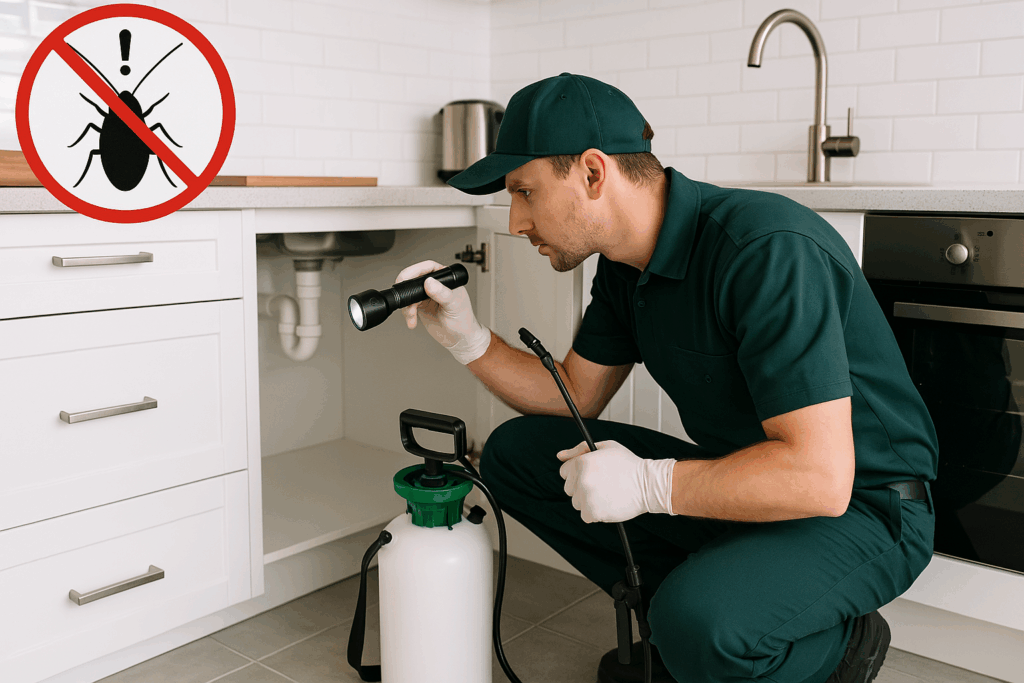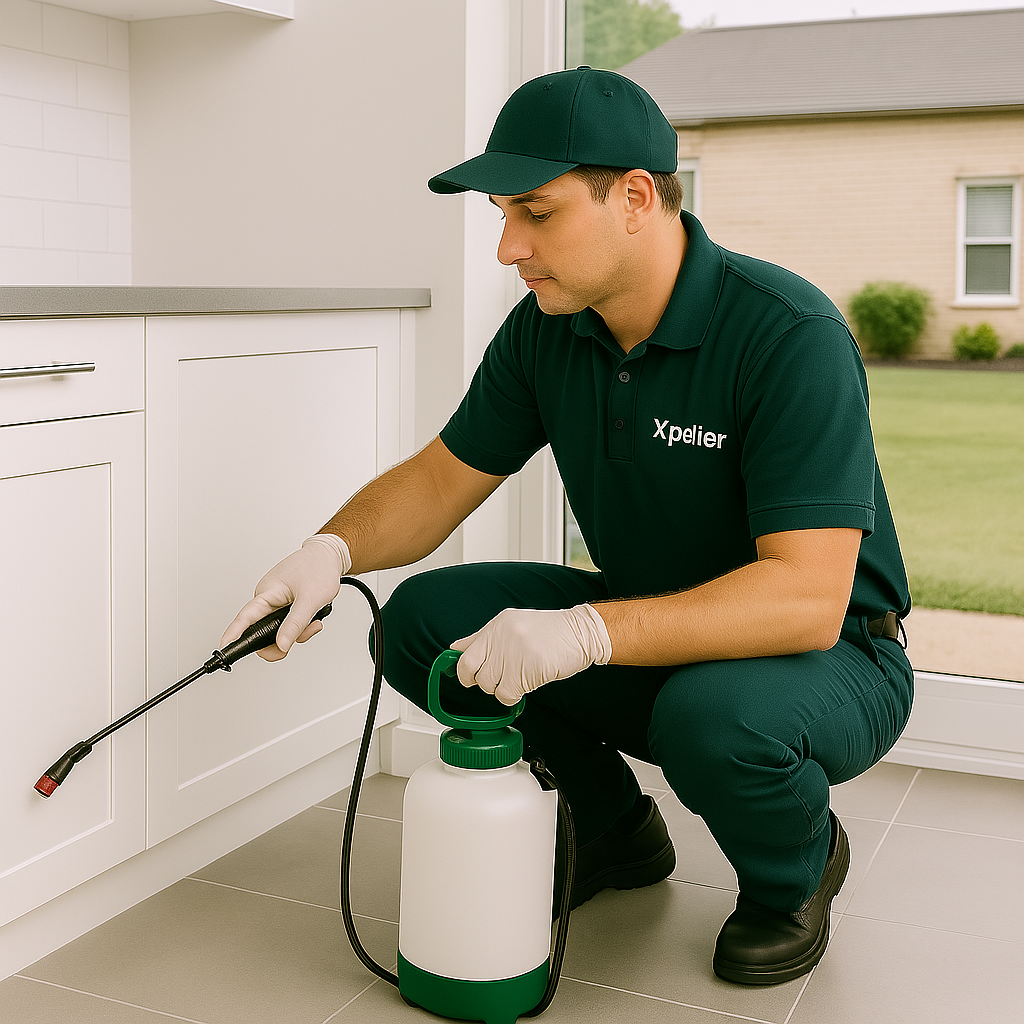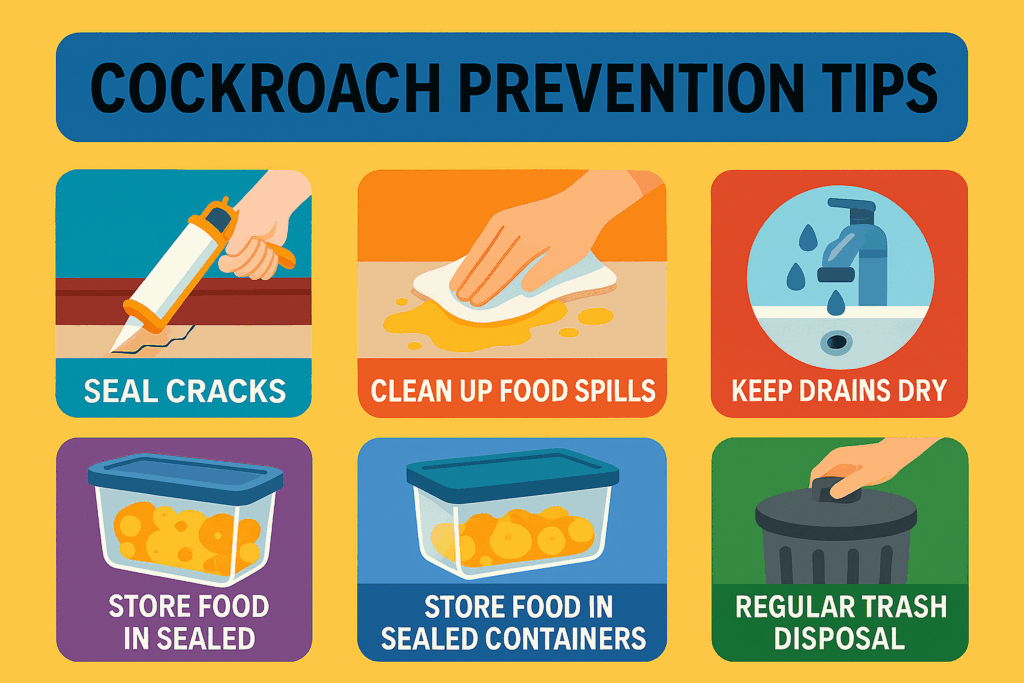1. Introduction to Cockroach Infestations

Cockroaches are one of the most unwelcome guests in any home. These small, sneaky creatures often crawl in unnoticed but can quickly turn into a full-blown nightmare. Let’s dive into the world of Cockroach Pest Control and how to deal with them effectively.
What are cockroaches?
Cockroaches are ancient insects—so ancient they’ve been around for over 300 million years. Yep, they’re survivors. They belong to the order Blattodea and are known for their flat bodies, long antennae, and speedy movements.
These pests can live almost anywhere—from kitchens and drains to wall cracks and furniture. They’re resilient, quick, and (unfortunately) clever at hiding.
Why are they a problem in homes?
Cockroaches are not just “icky.” They can:
- Contaminate food
- Spread bacteria and allergens
- Multiply at lightning speed
- Leave behind a nasty smell
A few roaches may seem harmless at first. But trust us, if you see one during the day, there are likely dozens more hiding.
Signs you have a cockroach infestation
Be on the lookout for:
- Droppings: Tiny black specks, like ground pepper.
- Egg cases (oothecae): Brown, oval-shaped capsules hidden in dark spots.
- Musty smell: A pungent, oily odor—especially in heavy infestations.
- Smear marks: Especially around water sources like sinks and bathrooms.
- Live or dead roaches: Obvious but alarming.
Common species found in homes
Here are the top cockroach species commonly found in homes:
- German Cockroach: These are small, tan-colored, and very common indoors, especially in kitchens and bathrooms.
- American Cockroach: Larger and reddish-brown in color, they often live in drains, basements, and sewer areas.
- Oriental Cockroach: Dark-colored and slow-moving, these are usually found in cool, damp places like basements and crawl spaces.
- Brown-Banded Cockroach: These prefer dry, warmer areas and are often found in high cabinets or behind picture frames.
2. Why Cockroaches Are Dangerous
Cockroaches don’t bite or sting, but that doesn’t make them harmless. They carry a long list of dangers.
Health risks caused by cockroaches
Cockroaches are dirty. They walk through garbage, sewage, and decaying matter. And guess what? They carry those germs into your home.
They’ve been known to carry bacteria like:
- Salmonella
- E. coli
- Staphylococcus
These bugs can turn your food into a ticking time bomb.
Cockroaches and food contamination
Roaches love hanging out in pantries and food containers. As they crawl around, they leave behind:
- Droppings
- Shed skin
- Saliva
- Bacteria
This can lead to food poisoning or even long-term digestive issues.
Allergic reactions and asthma
Cockroach allergens are a real thing. Their body parts, feces, and saliva can:
- Trigger asthma attacks
- Cause skin rashes
- Lead to sneezing fits
Kids are especially vulnerable. In fact, studies show a strong link between roach exposure and childhood asthma.
Psychological discomfort and stress
Let’s be honest—seeing a cockroach dart across your kitchen floor is enough to raise your blood pressure. Living with roaches can cause:
- Insomnia
- Anxiety
- Constant fear of contamination
It’s not just about health. It’s about peace of mind.
3. Causes of Cockroach Infestation
You might wonder: “Why me?” The truth is, cockroaches love any space that gives them food, water, and shelter. Let’s look at what attracts them.
Poor sanitation and food sources
Even tiny crumbs can invite an infestation.
- Open garbage cans
- Dirty dishes in the sink
- Spilled pet food
- Food not stored in airtight containers
Water sources and moist environments
Roaches can survive a month without food, but only a week without water.
- Leaky faucets
- Wet sponges
- Standing water
- Humid bathrooms
Cracks and entry points
They’re small and sneaky. They slip through:
- Gaps in doors and windows
- Wall cracks
- Utility lines
- Drains
External factors (season, location)
In warm climates, cockroaches are a year-round problem. In colder regions, they become more active indoors during fall and winter.
4. DIY Cockroach Pest Control Methods
You don’t always need to jump straight to chemicals or exterminators. There are safe, home-based methods to try first.
Natural remedies at home
Here are some natural home remedies to get rid of cockroaches:
- Baking Soda & Sugar: Mix equal parts of both. The sugar attracts the cockroaches, and the baking soda kills them when they eat it.
- Boric Acid: A very effective powder. Sprinkle it in dry and hidden areas like behind appliances and under sinks.
- Essential Oils: Scents like peppermint, eucalyptus, and tea tree oil are known to repel cockroaches. Mix with water and spray in affected areas.
- Lemon Juice: Its strong smell and acidic nature help keep cockroaches away. You can add it to your cleaning water.
Homemade baits and traps
Sticky traps and jar traps are easy and cheap.
- Coat a glass jar’s inside with petroleum jelly. Add some bait. Roaches climb in but can’t escape.
- Use duct tape sticky side up with food in the center.
Cleaning tips to deter roaches
- Vacuum regularly
- Wipe kitchen counters at night
- Take trash out daily
- Don’t leave dishes in the sink overnight
Limitations of DIY solutions
- Not effective in large infestations
- May not reach hidden nests
- Require consistency and patience
5. Professional Cockroach Pest Control Services

Sometimes, home remedies just aren’t enough—especially when you’re dealing with a stubborn infestation. That’s where the pros come in.
When to call the pros
If any of these signs appear, it’s time to bring in a pest control service:
- You see cockroaches during the day (they’re usually nocturnal—so this means overpopulation)
- DIY solutions aren’t working
- You spot egg cases frequently
- Family members develop asthma or allergies
- You’re just… tired of fighting the war
Types of treatments used
Professional pest control companies use several powerful methods to eliminate cockroaches. Here are some of the most common:
- Gel Baits: These are easy to hide and very effective. Cockroaches eat the bait and carry the poison back to their nest, spreading it to others.
- Insect Growth Regulators (IGRs): These stop cockroaches from growing or reproducing, which helps reduce the population over time.
- Residual Sprays: These are sprayed into cracks and hidden spots where cockroaches like to hide. They stay active for a while and kill any roach that touches the area.
- Dusts and Powders: Substances like boric acid or diatomaceous earth are used in dry places to kill cockroaches slowly but effectively.
What to expect during the service
It’s not scary—here’s what usually happens:
- Inspection – The technician checks your home for signs and entry points.
- Treatment – They apply baits, sprays, or dust in key areas.
- Advice – You’ll get a list of do’s and don’ts post-treatment.
- Follow-up – Some services offer a second visit to ensure total extermination.
Cost and long-term value
Pricing varies based on the severity and size of the space:
- One-time treatment: $100–$300
- Quarterly service: $80–$120 per visit
- Yearly plans: Can be cost-effective for ongoing protection
Yes, it’s an investment. But so is your health—and your sanity.
6. Preventing Cockroach Infestations
Stopping roaches before they move in is the smartest strategy. Here’s how to keep them out for good.

Home sealing and maintenance tips
- Seal all cracks in walls and baseboards
- Install door sweeps and weather stripping
- Cover vents and drains with mesh
- Use caulk around windows, sinks, and bathtubs
Proper food and waste management
Roaches are always looking for an easy meal. To keep them away, follow these tips:
- Store all food in airtight containers so roaches can’t smell or reach it.
- Clean up crumbs and food spills right away—especially in the kitchen.
- Don’t leave pet food out overnight, as it attracts roaches too.
- Make sure your trash bins have tight-fitting lids and take the trash out regularly.
Routine cleaning habits
A tidy home isn’t enough—stay vigilant:
- Wipe down kitchen surfaces daily
- Mop floors weekly
- Empty vacuum bags regularly
- Clean behind appliances (fridges and ovens are roach hotels)
Using safe repellents
Not into chemicals? Try these:
- Bay leaves (they hate the smell)
- Cucumber peels (yes, really)
- Citrus-based cleaners
- Essential oil sprays (especially peppermint and lavender)
7. Organic vs. Chemical Cockroach Control
Choosing the right method depends on your home, family, and priorities.
Pros and cons of chemical methods
Pros:
- Quick and powerful
- Targets hidden infestations
- Often requires fewer treatments
Cons:
- Can be toxic to pets or kids
- Might require temporary evacuation
- Possible odor or residue
Benefits of organic pest control
Why people love going natural:
- Safe for families and pets
- Environmentally friendly
- Minimal disruption
Here are some popular natural options for getting rid of cockroaches:
- Neem oil sprays – A natural insecticide that disrupts the pests’ life cycle.
- Diatomaceous earth – A fine powder that damages the roaches’ exoskeleton, causing them to dehydrate and die.
- Traps using essential oils – Oils like peppermint or eucalyptus can be used in traps to repel or kill roaches.
- Garlic or chili powder-based solutions – These strong-smelling spices can keep cockroaches away when sprinkled in problem areas.
Safety concerns for pets and kids
Children and pets are curious. That’s why safety matters.
- Avoid placing traps where kids play
- Store sprays and powders out of reach
- Use only pet-safe treatments indoors
Choosing the right solution
Ask yourself:
- How bad is the infestation?
- Do I have pets or kids?
- Do I prefer quick results or safe, slow progress?
Sometimes, a mix of both worlds—IPM (Integrated Pest Management)—works best.
8. Real-Life Case Studies & Success Stories
Don’t just take our word for it. Here are real-life examples of people who fought cockroaches—and won.
Residential success stories
Case 1: Small Apartment in Toronto
- Problem: Severe infestation in kitchen cabinets
- Action: Gel bait and IGR combo
- Result: 90% gone in 2 weeks, total elimination in 4 weeks
Case 2: Family Home in Calgary
- Problem: Roaches in bathroom and laundry room
- Action: Diatomaceous earth + sealing cracks
- Result: No sightings in 1 month
Commercial pest control cases
Case 3: Restaurant in Vancouver
- Problem: Roaches in pantry and dishwashing area
- Action: Monthly professional treatments
- Result: Passed health inspection, stayed roach-free
Case 4: Grocery Store in Montreal
- Problem: Roaches in storage and under fridges
- Action: Organic + chemical hybrid approach
- Result: Infestation cleared without closing store
Lessons learned from infestations
- Don’t wait too long—early action saves time and money
- Cleanliness alone doesn’t guarantee safety
- Professional advice goes a long way
Customer feedback and reviews
Here are some real experiences shared by people who dealt with cockroach problems:
- “I was terrified at first, but the pest control team explained everything clearly. No more nightmares!” – Sarah J.
- “Used peppermint oil and it actually worked. Just be consistent!” – Ravi K.
- “Worth every penny. The pros did in one week what I couldn’t do in three months.” – Martin D.
9. Conclusion
Cockroaches are tough. But so are you.
The key is early action, consistent cleanliness, and choosing the right solution. Whether you go natural or call in the pros, there is a path to a roach-free life.
Stay alert. Seal your home. Clean often. And don’t let the little bugs win.
10. FAQs
1. How do I know if I have a cockroach problem?
Look for droppings, musty odors, egg cases, and live roaches. If you see them during the day, it’s serious.
2. What’s the fastest way to kill cockroaches?
Gel baits and professional treatments work quickly. Baking soda traps also help in small areas.
3. Are cockroach sprays safe for pets?
Some are, some aren’t. Always read labels and use only pet-safe options indoors.
4. Can cockroaches come back after treatment?
Yes, if entry points and food sources aren’t managed. Follow prevention tips.
5. Is it worth hiring a pest control company?
Absolutely, especially for large infestations. They provide long-term, effective results.
